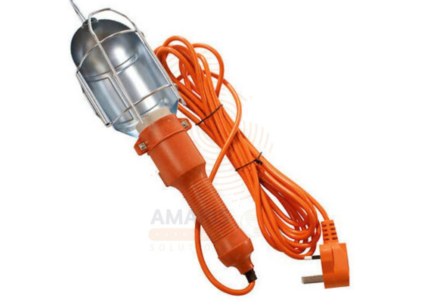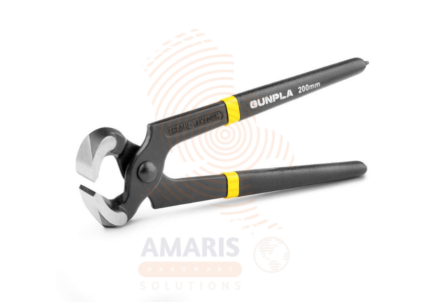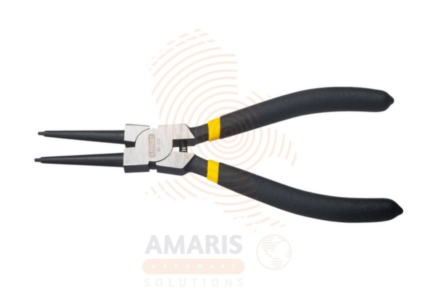
Working Lamp
$20.38 Original price was: $20.38.$19.36Current price is: $19.36.

Welding Mask
$13.00 Original price was: $13.00.$12.35Current price is: $12.35.
Wrecking Bar
$23.46 Original price was: $23.46.$22.29Current price is: $22.29.
WhatsApp Order
A wrecking bar, also known as a pry bar or crowbar, is a hand tool with a flat, chisel-like blade at one end and a curved or hooked end at the other. It is designed for leveraging, prying, and dismantling various materials such as wood, metal, or masonry. Wrecking bars are commonly used in construction, demolition, and other tasks where the application of force for separating or dislodging materials is required.
Category: HAND TOOLS
Tags: construction tool, crowbar, demolition bar, heavy duty bar, lever tool, manual prying tool, nail puller, pry bar, wrecking bar
Description
Table of Contents
ToggleWrecking Bar
Uses
-
Demolition: Wrecking bars are widely used in demolition work to pry apart or dismantle structures, break down walls, remove nails, and separate materials.
-
Construction: In construction projects, wrecking bars are employed for tasks such as removing old fixtures, pulling out nails, or separating materials that are fastened together.
-
Carpentry: Carpenters use wrecking bars to remove old boards, disassemble structures, and extract nails or other fasteners from wood.
-
Renovation: During renovation projects, wrecking bars prove useful for breaking down walls, removing old flooring, and taking apart structures before the installation of new materials.
-
Moving Heavy Objects: Wrecking bars can be used to leverage or lift heavy objects, helping to create space or dislodge items that may be stuck.
-
Auto Repairs: In automotive repairs, wrecking bars can be utilized for tasks like prying apart parts, removing stubborn components, or assisting in the disassembly of damaged sections.
-
Emergency Situations: Wrecking bars can be valuable in emergency situations, such as freeing someone trapped in debris after a disaster or assisting in rescues by creating openings in structures.
-
Landscaping: In landscaping projects, wrecking bars can be used for tasks like removing old fencing, disassembling wooden structures, or prying out rocks or stones embedded in the soil.
-
Home Improvement: For DIY home improvement projects, wrecking bars come in handy for tasks like removing old cabinets, extracting nails, or disassembling furniture.
-
Utility Work: Wrecking bars are useful in utility-related tasks, such as breaking open pavement, accessing underground structures, or prying apart materials in utility installations.
SAFETY HANDLING PRECAUTIONS
Safety Precautions
-
Wear Personal Protective Equipment (PPE):
-
Safety glasses: Protect your eyes from flying debris or particles.
-
Gloves: Wear sturdy work gloves to protect your hands from splinters, sharp edges, or injuries.
-
-
Check the Condition of the Wrecking Bar:
-
Ensure that the wrecking bar is in good condition with no cracks, bends, or other defects that could compromise its strength.
-
-
Choose the Right Tool for the Job:
-
Select the appropriate size and type of wrecking bar for the task at hand. Using the right tool can enhance efficiency and reduce the risk of accidents.
-
-
Inspect the Work Area:
-
Clear the work area of any obstacles, debris, or tripping hazards. Make sure there is enough space to maneuver the wrecking bar safely.
-
-
Secure the Workpiece:
-
Ensure that the material you are working on is stable and securely positioned. This helps prevent unexpected movement or collapse, reducing the risk of injuries.
-
-
Maintain Proper Body Mechanics:
-
Use proper body mechanics to avoid strains and injuries. Bend your knees and keep your back straight when lifting or applying force. Avoid overexertion.
-
-
Be Mindful of Surroundings:
-
Be aware of your surroundings and the presence of other people. Communicate with coworkers to prevent accidental collisions or interference.
-
-
Use Correct Techniques:
-
Employ proper prying techniques to maximize efficiency and minimize the risk of the wrecking bar slipping or causing sudden movements.
-
-
Beware of Flying Debris:
-
Take precautions to protect yourself from flying debris, especially when prying or breaking apart materials. Warn others in the vicinity and use barriers if necessary.
-
-
Avoid Overexertion:
-
Know your physical limits and avoid overexertion. Take breaks as needed and switch tasks to prevent fatigue.
-
-
Inspect Nails and Fasteners:
-
Check for loose or protruding nails in the material before prying. This helps prevent injuries and ensures a smoother demolition process.
-
-
Store the Wrecking Bar Safely:
-
When not in use, store the wrecking bar in a designated area away from walkways and ensure it is secured to prevent accidental falling or tripping.
-
Related products
Ball Point Hex Wrench Set – Short
A Ball Point Hex Wrench Set - Short refers to a collection of nine hexagonal (hex) wrenches, commonly known as Allen wrenches, designed with a ballpoint tip for easy access and angled entry into hexagonal socket screws. The term "short" indicates that these wrenches have shorter shafts compared to standard-sized wrenches. This set is likely to be compact and versatile, suitable for various applications where hex screws of different sizes need to be tightened or loosened efficiently. The ballpoint tips allow for a degree of flexibility in the angle of approach, making them particularly useful in situations where direct access may be challenging.
Carpenter’s Pincers
Carpenter's pincers, also known as end-cutting pliers or end nippers, are a type of hand tool used in carpentry and woodworking. They typically have sharp, pointed jaws that come together in a cutting edge at the tips. These pincers are designed for gripping, cutting, and pulling materials such as nails, wires, or small objects in woodworking applications. The jaws are angled to provide leverage and facilitate precise cutting or gripping in tight spaces. Carpenter's pincers are a versatile tool commonly found in a carpenter's toolkit for various tasks related to shaping and assembling wood.
Combination spanner set
A combination spanner set typically refers to a collection of twelve different-sized spanners that feature both open-end and box-end configurations. Combination spanners are versatile tools commonly used in mechanical and household applications. The open end is designed to grip fasteners in tight spaces, while the box end provides a more secure grip on the flats of a nut or bolt.
The set usually includes a range of sizes to accommodate various fastener dimensions. Each spanner in the set may be marked with its specific size, typically in metric or imperial units. This versatile tool set is essential for tasks that require tightening or loosening nuts and bolts in different applications, providing flexibility and convenience for the user.
Electronic Wire Stripper
An electronic wire stripper is a specialized handheld tool designed for efficiently and accurately removing the insulation or outer covering from electrical wires. It incorporates motorized or automated mechanisms to cut through and strip the insulation without damaging the underlying conductive wire. This tool is commonly used in electrical and electronic applications to streamline the process of preparing wires for connection, ensuring precision and reducing the risk of damage to the wire during the stripping process.
External Circlip Pliers Straight
External circlip pliers – straight, also known simply as external circlip pliers or snap ring pliers, are specialized hand tools designed for installing and removing external circlips or snap rings. Circlips are ring-shaped fasteners with open ends that fit into machined grooves on the outside of a shaft or bore. External circlip pliers are specifically designed to work with these types of retaining rings.
The "straight" designation indicates that the tips of the pliers are aligned in a straight line, as opposed to angled or curved tips. This straight configuration allows for easier access to circlips in certain applications.
These pliers typically have pointed or semi-circular jaws that fit into the holes or notches of the circlip, facilitating the compression or expansion of the ring for installation or removal. The handles are designed for comfortable grip and effective leverage.
F-Clamp
An F-clamp, also known as a bar clamp or sliding clamp, is a woodworking tool designed for holding and securing materials in place during the process of gluing, welding, or other similar tasks. It typically consists of two parallel jaws—one fixed and one movable—that can be adjusted along a bar or rail. The movable jaw can be positioned and tightened using a threaded mechanism, allowing the clamp to firmly grip and hold objects of various sizes. F-clamps are widely used in carpentry, metalworking, and other applications where a strong and adjustable clamping force is needed to ensure precision and stability during work.
Flat Hand Steel File
PRODUCT DESCRIPTION
A flat hand file is a type of hand tool used in metalworking and woodworking to remove material from a workpiece by abrasion. It consists of a flat, elongated piece of metal with parallel rows of teeth or ridges, called the file's "cut," which are designed to cut or shape a material when rubbed against it. Flat hand files are typically rectangular in shape and come in various sizes and coarseness grades, allowing for different levels of material removal and finishing. These files are commonly used for smoothing, shaping, and leveling surfaces in a variety of applications, providing a versatile means of material removal in manual craftsmanship.
Folding Saw
A folding saw is a compact and portable cutting tool designed for outdoor and survival activities. It typically features a serrated blade that folds into a handle, allowing for safe and convenient storage when not in use. Folding saws are commonly used for cutting through wood, branches, or other vegetation during camping, hiking, and various outdoor adventures. The folding design enhances portability and safety, making it a versatile tool for enthusiasts and professionals alike.


 Acrylic Sealants
Acrylic Sealants Construction Adhesives
Construction Adhesives Double-Sided Tape
Double-Sided Tape Duct Tape
Duct Tape Electrical Tape
Electrical Tape Epoxy & Resins
Epoxy & Resins Masking Tape
Masking Tape
 Automotive Wrenches & Socket Sets
Automotive Wrenches & Socket Sets Battery Chargers & Jump Starters
Battery Chargers & Jump Starters Car Jacks & Stands
Car Jacks & Stands Car Wash & Detailing Products
Car Wash & Detailing Products Diagnostic Tools
Diagnostic Tools Tire Inflators
Tire Inflators Vehicle Lighting
Vehicle Lighting Oil & Lubricants
Oil & Lubricants
 Adhesives & Sealants
Adhesives & Sealants Bricks & Blocks
Bricks & Blocks Cement & Concrete
Cement & Concrete Drywall & Plaster
Drywall & Plaster Flooring (Tiles, Wood, Laminate)
Flooring (Tiles, Wood, Laminate) Lumber & Plywood
Lumber & Plywood Paints, Primers & Coatings
Paints, Primers & Coatings Insulation Materials
Insulation Materials Roofing Materials
Roofing Materials
 Circuit Breakers
Circuit Breakers Electrical Cables & Wires
Electrical Cables & Wires Switches & Sockets
Switches & Sockets Fuses & Relays
Fuses & Relays Connectors & Terminals
Connectors & Terminals Electrical Boxes & Panels
Electrical Boxes & Panels Conduit & Fittings
Conduit & Fittings Lighting Fixtures & Bulbs
Lighting Fixtures & Bulbs Extension Cords & Power Strips
Extension Cords & Power Strips
 Anchors
Anchors Bolts
Bolts Clips & Clamps
Clips & Clamps Screws
Screws Nuts
Nuts Washers
Washers Rivets
Rivets Nails
Nails Threaded Rods
Threaded Rods
 Hammers
Hammers Measuring Tools (Tapes, Levels, Calipers)
Measuring Tools (Tapes, Levels, Calipers) Screwdrivers
Screwdrivers Pliers & Cutters
Pliers & Cutters Saws & Blades
Saws & Blades Chisels & Punches
Chisels & Punches Allen Keys & Hex Keys
Allen Keys & Hex Keys Ratchets & Socket Sets
Ratchets & Socket Sets Wrenches & Spanners
Wrenches & Spanners
 Power Tool Accessories (Blades, Bits, Discs)
Power Tool Accessories (Blades, Bits, Discs) Rotary Tools
Rotary Tools Saws (Circular, Jigsaw, Reciprocating)
Saws (Circular, Jigsaw, Reciprocating) Drills & Drivers
Drills & Drivers Grinders & Sanders
Grinders & Sanders Heat Guns
Heat Guns Nail Guns
Nail Guns Impact Wrenches
Impact Wrenches Batteries & Chargers
Batteries & Chargers
 Pipes & Fittings (PVC, Copper, PEX)
Pipes & Fittings (PVC, Copper, PEX) Plumbing Tools
Plumbing Tools Pumps & Motors
Pumps & Motors Sealants & Adhesives for Plumbing
Sealants & Adhesives for Plumbing Valves & Taps
Valves & Taps Water Heaters
Water Heaters Drainage Systems
Drainage Systems Faucets & Fixtures
Faucets & Fixtures Hoses & Tubing
Hoses & Tubing
 Hinges & Latches
Hinges & Latches Hooks & Brackets
Hooks & Brackets Window Hardware
Window Hardware Chains & Cables
Chains & Cables Casters & Wheels
Casters & Wheels Shelving & Storage Systems
Shelving & Storage Systems Door Handles & Locks
Door Handles & Locks Drawer Slides & Cabinet Hardware
Drawer Slides & Cabinet Hardware
 Personal Protective Equipment (PPE)
Personal Protective Equipment (PPE) Respirators & Masks
Respirators & Masks Safety Glasses
Safety Glasses Safes
Safes Security Cameras
Security Cameras Gloves
Gloves Helmets
Helmets Ear Protection
Ear Protection Fire Safety Equipment
Fire Safety Equipment Locks & Padlocks
Locks & Padlocks Motion Sensors & Alarms
Motion Sensors & Alarms
 Garden Fencing
Garden Fencing Garden Furniture Hardware
Garden Furniture Hardware Lawn Mowers
Lawn Mowers Trimmers & Edgers
Trimmers & Edgers Shovels & Spades
Shovels & Spades Rakes & Hoes
Rakes & Hoes Pruning Shears & Loppers
Pruning Shears & Loppers Watering Systems (Hoses, Sprinklers, Nozzles)
Watering Systems (Hoses, Sprinklers, Nozzles)
 Interior Paints
Interior Paints Paint Brushes & Rollers
Paint Brushes & Rollers Paint Strippers & Thinners
Paint Strippers & Thinners Paint Trays & Accessories
Paint Trays & Accessories Exterior Paints
Exterior Paints Spray Paints
Spray Paints Primers & Undercoats
Primers & Undercoats Varnishes & Stains
Varnishes & Stains
 Gaskets & Seals
Gaskets & Seals Hydraulic Fittings
Hydraulic Fittings Industrial Fasteners
Industrial Fasteners Industrial Hoses
Industrial Hoses Lubricants & Greases
Lubricants & Greases Metal Sheets & Bars
Metal Sheets & Bars Bearings & Bushings
Bearings & Bushings Belts & Pulleys
Belts & Pulleys
 HVAC Filters
HVAC Filters Insulation for HVAC
Insulation for HVAC Air Conditioners
Air Conditioners Refrigerants
Refrigerants Ventilation Ducts & Fittings
Ventilation Ducts & Fittings Thermostats & Controllers
Thermostats & Controllers Fans & Blowers
Fans & Blowers
 Pegboards & Hooks
Pegboards & Hooks Shelving Units
Shelving Units Storage Bins & Containers
Storage Bins & Containers Toolboxes & Tool Chests
Toolboxes & Tool Chests Workbenches
Workbenches Drawer Organizers
Drawer Organizers Labeling Supplies
Labeling Supplies
 Welding Accessories (Clamps, Brushes)
Welding Accessories (Clamps, Brushes) Welding Electrodes & Rods
Welding Electrodes & Rods Welding Helmets & Gloves
Welding Helmets & Gloves Welding Machines
Welding Machines Soldering Irons & Stations
Soldering Irons & Stations Flux & Solder Wire
Flux & Solder Wire
 Generator Accessories
Generator Accessories Inverters
Inverters Portable Generators
Portable Generators Power Inverters
Power Inverters Transfer Switches
Transfer Switches Diesel & Gasoline Generators
Diesel & Gasoline Generators
 Transport Equipment: Carts, Dollies, and Hand Trucks
Transport Equipment: Carts, Dollies, and Hand Trucks Storage Solutions: Pallets, Racks, and Containers
Storage Solutions: Pallets, Racks, and Containers Lifting Equipment: Hoists, Cranes, and Jacks
Lifting Equipment: Hoists, Cranes, and Jacks Conveyors and Accessories: Belts and Rollers
Conveyors and Accessories: Belts and Rollers











